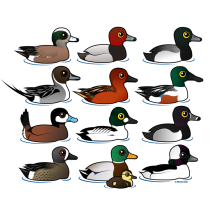Also known as: Broad-nosed Duck, Common Shoveler, European Shoveler, European Shoveller, Northern Shoveller, Shoveler, Shoveller, Spoonbill Duck
The Northern Shoveler, a distinctive species of duck, is widely distributed across North America, Europe, and Asia. This bird is particularly noted for its unique bill, which is broad and spatula-like, setting it apart from other ducks.
During the breeding season, the male Northern Shoveler displays a striking plumage with a radiant green head, rich chestnut underparts, and a contrasting white breast. Outside of the breeding season, and in females year-round, the plumage is more subdued, featuring a mottled brown coloration that provides excellent camouflage. Despite these differences in appearance, both sexes are united by their characteristic wide bills.
As dabbling ducks, Northern Shovelers feed primarily on plant material. They have a unique foraging technique, swimming with their bills submerged to sift through the water for food. Their diet is varied and, during the breeding season, is supplemented with animal matter such as insects, small crustaceans, and mollusks.
Northern Shovelers are highly migratory, undertaking long journeys to warmer climates during the winter. This migratory behavior ensures they can exploit different habitats seasonally, which is vital for their feeding and breeding success. Their presence across such diverse regions highlights their adaptability and the importance of various wetland habitats for migratory waterfowl.










































